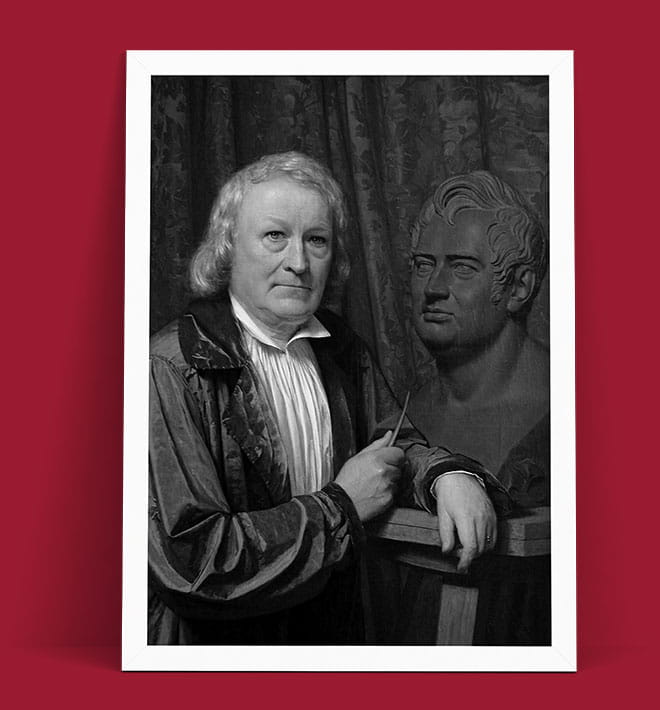Bertel Thorvaldsen: The Neoclassical Titan of Denmark
Early Life and Education
Bertel Thorvaldsen was born on November 19, 1770, in Copenhagen, Denmark, to an Icelandic father, who was a woodcarver, and a Danish mother. His upbringing was modest, and from a young age, he assisted his father with woodwork, learning the basics of form and craft. His early talent in drawing and sculpting was noticed quickly, leading to his enrollment at the Royal Danish Academy of Fine Arts when he was just eleven years old.
At the Academy, Thorvaldsen excelled, winning several awards for his exceptional skill in classical sculpture. By 1793, he had received the Academy’s highest honor—the gold medal—which came with a traveling stipend. It took him several years to embark on that journey, but by 1797, he finally made his way to Rome, the epicenter of classical art, and the city that would define his career.
Rome and the Birth of a Neoclassical Master
In Rome, Thorvaldsen immersed himself in the study of ancient Greek and Roman sculpture. He was greatly inspired by the works of antiquity and the ideals of neoclassicism, which emphasized harmony, clarity, and restraint. While living among ruins and Renaissance masters, he developed his own pure and serene sculptural language.
His major breakthrough came in 1803 with the colossal statue "Jason with the Golden Fleece", which was hailed as a neoclassical triumph and earned him instant recognition across Europe. From then on, Bertel Thorvaldsen became one of the most sought-after sculptors of his time, receiving commissions from royalty, the Vatican, and aristocrats across the continent.
Ganymede and the Eagle
Among Thorvaldsen’s most beloved mythological pieces is "Ganymede and the Eagle", a stunning representation of the Greek myth in which Zeus, in the form of an eagle, abducts the beautiful Trojan youth Ganymede. The sculpture exemplifies Thorvaldsen’s skill in rendering anatomy with elegance and grace, while capturing the idealized beauty so central to neoclassical thought.
Ganymede and the Eagle is notable not just for its aesthetic perfection but for how it captures an emotionally charged moment—Ganymede’s ascension to immortality—as a calm, timeless gesture, free from melodrama.
Christus and the Apostles
Thorvaldsen’s religious commissions include his monumental statues of Christus and the Twelve Apostles, located in the Church of Our Lady (Vor Frue Kirke) in Copenhagen. The Christus statue, in particular, became iconic, embodying a sense of divine peace and acceptance. It is one of the most widely replicated religious sculptures in the world today.
Other Significant Works
- The Lion Monument in Lucerne, commemorating Swiss Guards killed during the French Revolution.
- Portrait busts of prominent figures like Pope Pius VII, Lord Byron, and Ludwig van Beethoven.
- Numerous friezes, medallions, and reliefs combining mythological themes with idealized human form.
The Thorvaldsen Museum
The culmination of Thorvaldsen’s legacy is the Thorvaldsen Museum, which opened in 1848 in Copenhagen, just four years after his death. It was the first museum in the world to be dedicated to the works of a single artist during their lifetime—an astonishing honor.
Designed by architect Michael Gottlieb Bindesbøll, the museum houses over 1,000 of Thorvaldsen’s original models, finished sculptures, personal effects, and his own art collection, including works from antiquity and Renaissance masters. Most importantly, Thorvaldsen himself is buried in the courtyard, beneath a bed of earth and flowers, according to his wishes. The museum stands today as a time capsule of the Neoclassical age and remains a key cultural destination in Denmark.
Style and Legacy
Thorvaldsen’s works are often compared to those of Antonio Canova, his Italian contemporary and rival. While Canova’s sculptures tend to be more emotionally expressive, Thorvaldsen’s lean toward stoic idealism, drawing directly from classical proportions and balance.
He is remembered as the great reviver of ancient sculpture in the modern age, helping define the Neoclassical movement across Europe. His influence extended beyond sculpture into painting, architecture, and even 19th-century national identity building.
In a time when Romanticism was taking root, Bertel Thorvaldsen remained a committed classicist, devoted to ideals of order, beauty, and serenity.
Final Years and Death
After more than 40 years in Rome, Thorvaldsen returned to Copenhagen in 1838 as a celebrated national hero. He continued to work and contribute to the Danish art scene until his death in 1844. As per his request, he was laid to rest at the Thorvaldsen Museum, in the heart of the city he helped shape artistically.






